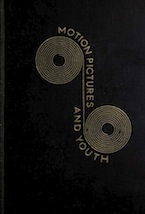Herbert Blumer. Movies and Conduct (1933)
MOTION PICTURES are not understood by the present generation of adults. They are new; they make an enormous appeal to children; and they present ideas and situations which parents may not like. Consequently when parents think of the welfare of their children who are exposed to these compelling situations, they wonder about the effect of the pictures upon the ideals and behavior of the children. Do the pictures really influence children in any direction? Are their conduct, ideals, and attitudes affected by the movies? Are the scenes which are objectionable to adults understood by children, or at least by very young children? Do children eventually become sophisticated and grow superior to pictures? Are the emotions of children harmfully excited? In short, just what effect do motion pictures have upon children of different ages?
Each individual has his answer to these questions. He knows of this or that incident in his own experience, and upon these he bases his conclusions. Consequently opinions differ widely. No one in this country up to the present time has known in any general and impersonal manner just what effect motion pictures have upon children. Meanwhile children clamor to attend the movies as often as they are allowed to go. Moving pictures make a profound appeal to children of all ages. In such a situation it is obvious that a comprehensive study of the influence of motion pictures upon children and youth is appropriate.
To measure these influences the investigators who cooperated to make this series of studies analyzed the problem
to discover the most significant questions involved. They set up individual studies to ascertain the answer to the questions and to provide a composite answer to the central question of the nature and extent of these influences. In using this technique the answers must inevitably be sketches without all the details filled in; but when the details are added the picture will not be changed in any essential manner. Parents, educators, and physicians will have little difficulty in fitting concrete details of their own into the outlines which these studies supply.
Specifically, the studies were designed to form a series to answer the following questions: What sorts of scenes do the children of America see when they attend the theaters? How do the mores depicted in these scenes compare with those of the community? How often do children attend? How much of what they see do they remember? What effect does what they witness have upon their ideals and attitudes? Upon their sleep and health? Upon their emotions? Do motion pictures directly or indirectly affect the conduct of children? Are they related to delinquency and crime, and, finally, how can we teach children to discriminate between movies that are artistically and morally good and bad?
The history of the investigations is brief. In 1928 William H. Short, Executive Director of the Motion Picture Research Council, invited a group of university psychologists, sociologists, and educators to meet with the members of the Council to confer about the possibility of discovering just what effect motion pictures have upon children, a subject, as has been indicated, upon which many conflicting opinions and few substantial facts were in existence. The university men proposed a program of study. When Mr. Short appealed to The Payne Fund for a grant to support such an investigation, he found the foundation receptive
because of its well-known interest in motion pictures as one of the major influences in the lives of modern youth. When the appropriation had been made the investigators organized themselves into a Committee on Educational Research of The Payne Fund with the following membership: L. L. Thurstone, Frank N. Freeman, R. E. Park, Herbert Blumer, Philip M. Hauser of the University of Chicago; George D. Stoddard, Christian A. Ruckmick, P. W. Holaday, and Wendell Dysinger of the University of Iowa; Mark A. May and Frank K. Shut tie worth of Yale University; Frederick M. Thrasher and Paul G. Cressey of New York University; Charles C. Peters of Pennsylvania State College; Ben D. Wood of Columbia University; and Samuel Renshaw, Edgar Dale, and W. W. Charters of Ohio State University. The investigations have extended through four years, 1929-1932 inclusive.
The committee's work is an illustration of an interesting technique for studying any social problem. The distinctive characteristic of this technique is to analyze a complex social problem into a series of subordinate problems, to select competent investigators to work upon each of the subordinate projects and to integrate the findings of all the investigators as a solution of the initial problem. Such a program yields a skeleton framework, which, while somewhat lacking in detail, is substantially correct if the contributing investigations have been validly conducted. To provide this framework or outline is the task of research. To fill in the detail and to provide the interpretations are the natural and easy tasks of those who use the data.
W. W. C. Ohio State University June, 1933


 .
.